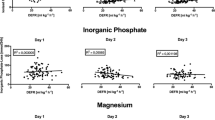Abstract
Objective
Hypophosphatemia often occurs during continuous renal replacement therapy (CRRT). The addition of phosphate to dialysate and replacement solutions facilitates phosphate handling, but the risk of precipitation with calcium within these solutions has not been addressed.
Design and setting
Experimental study with a retrospective observational study in a medico-surgical intensive care unit.
Methods and patients
We tested the addition of phosphate to calcium-rich lactate- and bicarbonate-based solutions (Hemosol LG2 and Hemosol B0) used in CRRT to see whether precipitation occurs. Two milliliters of potassium phosphate added to 5-l bags gives a physiological phosphate concentration of 1.2 mmol/l. In addition, calcium and phosphate homeostasis was retrospectively evaluated in 20 consecutive CRRT patients where potassium phosphate had been added to these solutions.
Measurements and results
Total and ionized calcium, phosphate, pH, PCO2 and bicarbonate remained essentially unchanged 5 h after the addition of 2 ml of potassium phosphate to 5-l Hemosol solutions. Visual inspection did not reveal any precipitate. Of the 20 patients studied, 14 received more than 24 h of phosphate supplementation to dialysate and replacement solutions. Phosphate remained stable throughout CRRT despite phosphate intake from nutrition in 11 cases. No adverse event was noted on potassium, calcium, pH and bicarbonate homeostasis.
Conclusions
The addition of phosphate to Hemosol solutions does not precipitate with the calcium within these solutions. This practical method effectively prevents hypophosphatemia in CRRT patients.

Similar content being viewed by others
References
Troyanov S, Cardinal J, Geadah D, Parent D, Courteau S, Caron S, Leblanc M (2003) Solute clearances during continuous venovenous haemofiltration at various ultrafiltration flow rates using Multiflow-100 and HF1000 filters. Nephrol Dial Transplant 18:961–966
Perreault MM, Ostrop NJ, Tierney MG (1997) Efficacy and safety of intravenous phosphate replacement in critically ill patients. Ann Pharmacother 31:683–688
Rosen GH, Boullata JI, O’Rangers EA, Enow NB, Shin B (1995) Intravenous phosphate repletion regimen for critically ill patients with moderate hypophosphatemia. Crit Care Med 23:1204–1210
Dorval M, Pichette V, Cardinal J, Geadah D, Ouimet D, Leblanc M (1999) The use of an ethanol- and phosphate-enriched dialysate to maintain stable serum ethanol levels during haemodialysis for methanol intoxication. Nephrol Dial Transplant 14:1774–1777
Chow MT, Lin HJ, Mitra EA, Singh S, Lee E, Leehey DJ, Ing TS (1998) Hemodialysis-induced hypophosphatemia in a normophosphatemic patient dialyzed for ethylene glycol poisoning: treatment with phosphorus-enriched hemodialysis. Artif Organs 22:905–907
Dunham B, Marcuard S, Khazanie PG, Meade G, Craft T, Nichols K (1991) The solubility of calcium and phosphorus in neonatal total parenteral nutrition solutions. JPEN J Parenter Enteral Nutr 15:608–611
Allwood MC, Kearney MC (1998) Compatibility and stability of additives in parenteral nutrition admixtures. Nutrition 14:697–706
Pereira-da-Silva L, Nurmamodo A, Amaral JM, Rosa ML, Almeida MC, Ribeiro ML (2003) Compatibility of calcium and phosphate in four parenteral nutrition solutions for preterm neonates. Am J Health Syst Pharm 60:1041–1044
Hicks W, Hardy G (2001) Phosphate supplementation for hypophosphataemia and parenteral nutrition. Curr Opin Clin Nutr Metab Care 4:227–233
Lumpkin MM (1994) Safety alert: hazards of precipitation associated with parenteral nutrition. Am J Hosp Pharm 51:1427–1428
McKinnon BT (1996) FDA safety alert: hazards of precipitation associated with parenteral nutrition. Nutr Clin Pract 11:59–65
Rose BD, Post TW (2001) Clinical physiology of acid-base and electrolyte disorders. McGraw-Hill, New York
Perry RH, Green DW, Maloney JO (1997) Perry’s chemical engineers’ handbook. McGraw-Hill, New York
Bugg NC, Jones JA (1998) Hypophosphataemia. Pathophysiology, effects and management on the intensive care unit. Anaesthesia 53:895–902
Paterson CR (1996) Hypophosphataemia: a dangerous disorder. Nutrition 12:540–541
Ronco C, Bellomo R, Homel P, Brendolan A, Dan M, Piccinni P, La Greca G (2000) Effects of different doses in continuous veno-venous haemofiltration on outcomes of acute renal failure: a prospective randomised trial. Lancet 356:26–30
Honore PM, Jamez J, Wauthier M, Lee PA, Dugernier T, Pirenne B, Hanique G, Matson JR (2000) Prospective evaluation of short-term, high-volume isovolemic hemofiltration on the hemodynamic course and outcome in patients with intractable circulatory failure resulting from septic shock. Crit Care Med 28:3581–3587
Brown GR, Greenwood JK (1994) Drug- and nutrition-induced hypophosphatemia: mechanisms and relevance in the critically ill. Ann Pharmacother 28:626–632
Van den Berghe G, Wouters P, Weekers F, Verwaest C, Bruyninckx F, Schetz M, Vlasselaers D, Ferdinande P, Lauwers P, Bouillon R (2001) Intensive insulin therapy in the critically ill patients. N Engl J Med 345:1359–1367
Author information
Authors and Affiliations
Corresponding author
Rights and permissions
About this article
Cite this article
Troyanov, S., Geadah, D., Ghannoum, M. et al. Phosphate addition to hemodiafiltration solutions during continuous renal replacement therapy. Intensive Care Med 30, 1662–1665 (2004). https://doi.org/10.1007/s00134-004-2333-2
Received:
Accepted:
Published:
Issue Date:
DOI: https://doi.org/10.1007/s00134-004-2333-2




